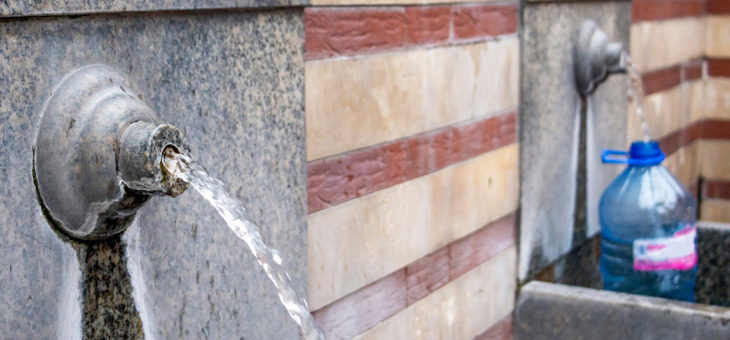In Australia, when you get thirsty, you go to the tap, turn it on and fill a glass with drinkable water, and you drink it.
People in other countries aren’t so lucky. And then when you visit those countries, you aren’t so lucky, either.
It’s important to stay hydrated at all times, but especially when you’re expending energy, which is usually the case when you travel.
Sightseeing makes you thirsty and having to buy bottled water can be expensive – not to mention terrible for the environment.
There’s a big push to make travel more sustainable and especially to cut down on the use of plastics. But where can you actually use your refillable water bottle? Where in the world is the tap water safe? Leon shares an exhaustive list of every country with safe drinking water and the countries where you should avoid it.
Drinking the tap water in around 187 countries can make you very sick: not necessarily because it’s polluted or unsafe, but because your system isn’t used to it. And it’s not just the ‘usual suspect’ countries that have dodgy water.
The team at Globehunters checked out advice from the CDC (US Centers for Disease Control and Prevention) and found recommendations to avoid the tap water some fairly major tourist destinations, such as Russia, China, Brazil, Turkey and Morocco.
The countries where you can’t drink the water are:
Afghanistan, Albania, Algeria, American Samoa, Angola, Anguilla, Antigua and Barbuda, Argentina, Armenia, Azerbaijan, Azores, Bahamas, Bangladesh, Barbados, Belarus, Belize, Benin, Bhutan, Bolivia, Bonaire, Bosnia and Herzegovina, Botswana, Brazil, British Indian Ocean Territory, British Virgin Islands, Brunei, Bulgaria, Burkina Faso, Burundi, Cambodia, Cameroon, Canary Islands, Cape Verde, Cayman Islands, Central African Republic, Chad, China, Christmas Island, Cocos (Keeling) Islands, Colombia, Comoros, Cuba, Cyprus, Democratic Republic of the Congo, Djibouti, Dominica, Dominican Republic, East Timor, Easter Island, Ecuador, Egypt, El Salvador, Equatorial Guinea, Eritrea, Eswatini, Ethiopia, Falkland Islands, Faroe Islands, Federated States of Micronesia, Fiji, French Guiana, French Polynesia, Gabon, Georgia, Ghana, Gibraltar, Grenada, Guam, Guatemala, Guinea, Guinea-Bissau, Guyana, Haiti, Honduras, Hong Kong, India, Indonesia, Iran, Iraq, Ivory Coast, Jamaica, Jordan, Kazakhstan, Kenya, Kiribati, Kosovo, Kyrgyzstan, Laos, Latvia, Lebanon, Lesotho, Liberia, Libya, Lithuania, Macau, Madagascar, Madeira, Malawi, Malaysia, Maldives, Mali, Marshall Islands, Mauritania, Mauritius, Mayotte, Mexico, Moldova, Mongolia, Montenegro, Montserrat, Morocco, Mozambique, Myanmar, Namibia, Nauru, Nepal, Nicaragua, Niger, Nigeria, Niue, Norfolk Island, North Korea, Northern Mariana Islands, Oman, Pakistan, Panama, Papua New Guinea, Paraguay, Peru, Philippines, Pitcairn Islands, Qatar, Republic of Macedonia, Republic of the Congo, Romania, Russia, Rwanda, Saba, Saint Barthelemy, Saint Kitts and Nevis, Saint Lucia, Saint Martin, Saint Pierre and Miquelon, Saint Vincent and the Grenadines, Samoa, Sao Tome and Principe, Senegal, Serbia, Seychelles, Sierra Leone, Sint Eustatius, Sint Maarten, Solomon Islands, Somalia, South Africa, South Georgia and the South Sandwich Islands, South Sudan, Sri Lanka, Sudan, Suriname, Syria, Taiwan, Tajikistan, Tanzania, Thailand, The Gambia, Togo, Tokelau, Tonga, Trinidad and Tobago, Tunisia, Turkey, Turkmenistan, Turks and Caicos Islands, Tuvalu, Uganda, Ukraine, Uruguay, Uzbekistan, Vanuatu, Venezuela, Vietnam, Wake Island, Western Sahara, Yemen, Zambia and Zimbabwe.
It’s important to note that the water in these countries in not necessarily unsafe; it just won’t agree with you.
So where is it safe to drink the water?
You can however, safely drink the water in Andorra, Aruba, Australia, Austria, Bahrain, Belgium, Bermuda, Canada, Chile, Cook Islands, Costa Rica, Croatia, Curacao, Czech Republic, Denmark, Estonia, Finland, France, Germany, Greece, Greenland, Guadeloupe, Hungary, Iceland, Israel, Italy, Japan, Kuwait, Liechtenstein, Luxembourg, Malta, Martinique, Monaco, Netherlands, New Caledonia, New Zealand, Norway, Palau, Poland, Portugal, Puerto Rico, Republic of I re land, Reunion, Saint Helena, San Marino, Saudi Arabia, Singapore, Slovakia, Slovenia, South Korea, Spain, Sweden, Switzerland, U.S. Virgin Islands, United Arab Emirates, United Kingdom, United States.
So, pack your water bottle, drink up and save on plastic bottle water purchases and save the environment, too!
Related articles:
Clean drinking water in seconds
Why day-old water might taste odd
What’s the tang in tap water?

